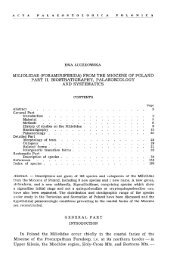The skull of Velociraptor - Acta Palaeontologica Polonica
The skull of Velociraptor - Acta Palaeontologica Polonica
The skull of Velociraptor - Acta Palaeontologica Polonica
You also want an ePaper? Increase the reach of your titles
YUMPU automatically turns print PDFs into web optimized ePapers that Google loves.
ACTA PALAEONTOLOGICA POLONICA (44) (2) 191<br />
Type horizon and locality: Djadokhta Formation (?early Campanian), Bayn Dzak, Ornnogov prov-<br />
ince, Gobi Desert, Mongolia.<br />
Material. -<strong>The</strong> present description <strong>of</strong> the <strong>skull</strong> <strong>of</strong> V: mongoliensis is based on several<br />
<strong>skull</strong>s pertaining to more or less complete skeletons from the Upper Cretaceous sand-<br />
stone deposits <strong>of</strong> the Mongolian Gobi. <strong>The</strong> specimens studied were found by the<br />
Polish-Mongolian <strong>Palaeontologica</strong>l Expeditions (specimens GIN 100125 and ZPAL<br />
MgD-U97, see Kielan-Jaworowska & Barsbold 1972; Gradziliski et al. 1977), by the<br />
Soviet-Mongolian <strong>Palaeontologica</strong>l Expeditions (specimen PIN 3 14318), by a Mongo-<br />
lian expedition (specimen GIN 100124, see Barsbold 1983) and by the Mongolian-<br />
-Japanese <strong>Palaeontologica</strong>l Expeditions (specimen GIN 10012000). Description <strong>of</strong> the<br />
postcrania preserved with these <strong>skull</strong>s will be published at a later date (Barsbold &<br />
Osm6lska in preparation).<br />
<strong>The</strong> following specimens derive from the Djadokhta Formation (?early Campanian,<br />
see Kielan-Jaworowska & Hurum 1997), TugrrE;zn-Shire, Omnogov, Mongolia:<br />
GIN 100124 - consists <strong>of</strong> an almost complete, articulated, but dorsoventrally flat-<br />
tened <strong>skull</strong>, both mandibular rami, and a few fragmentary postcranial bones. <strong>The</strong><br />
premaxillae are damaged rostrally, as are the caudal ends <strong>of</strong> the nasals and the rostral<br />
tips <strong>of</strong> the frontals along their mutual contact; the shaft and the caudal end <strong>of</strong> the left<br />
lacrimal are missing; jugals, quadratojugals and quadrates are fragmentary; pterygoids<br />
and palatines are partly damaged, those on the left side having shifted caudally from<br />
their natural position; vomers are not exposed. <strong>The</strong> dentaries are positioned between<br />
the left and right maxillae and premaxillae; the postdentary portion <strong>of</strong> the right man-<br />
dibular ramus is fragmentary, the left surangular lacks its rostrodorsal part; the dentary<br />
teeth and articular region are not exposed.<br />
GIN 100125 - includes skeletons <strong>of</strong> two dinosaurs - V: mongoliensis and Proto-<br />
ceratops andrewsi. Remains <strong>of</strong> these dinosaurs are preserved in a position suggestive<br />
<strong>of</strong> combat and for that reason this specimen is widely known as one <strong>of</strong> the 'fighting di-<br />
nosaurs'. <strong>The</strong> V mongoliensis skeleton is complete and articulated. It includes the<br />
<strong>skull</strong>, adducted mandibles and postcranium. <strong>The</strong> snout and mandible are somewhat<br />
compressed laterally and the dentaries are forced under the <strong>skull</strong> obscuring the palate<br />
and rostral part <strong>of</strong> the basicranium.<br />
GIN 10012000 - is represented by the complete skeleton <strong>of</strong> a young individual. It<br />
includes <strong>skull</strong> with mandible and postcranium.<br />
PIN 314318 - almost complete <strong>skull</strong> with left mandibular ramus, lacking the right<br />
temporal region; tip <strong>of</strong> the rostrum is severely damaged.<br />
<strong>The</strong> Barun Goyot Formation (?late Campanian: Kielan-Jaworowska & Hurum<br />
1997), Khulsan, Bayankhongor, Mongolia, yielded one specimen ZPAL MgD-U97 -<br />
included is the left, rostral half <strong>of</strong> the <strong>skull</strong> (exposed from the medial side) but lacks the<br />
premaxilla and tips <strong>of</strong> the vomers. Both mandibular rami are placed between the<br />
maxillae (as in all described V mongoliensis specimens with the mandible preserved);<br />
the left ramus lacks the caudal articular region and the tip <strong>of</strong> the dentary; the fragmen-<br />
tary right ramus includes the splenial and an incomplete dentary. Associated with the<br />
<strong>skull</strong> was a distal part <strong>of</strong> the left hind limb.<br />
<strong>The</strong> new, abundant <strong>Velociraptor</strong> material recently collected in Mongolia by the Mon-<br />
golian Academy <strong>of</strong> Sciences - American Museum <strong>of</strong> Natural History Expeditions<br />
(Norell & Makovicky 1998) has not been studied by the present authors.

















